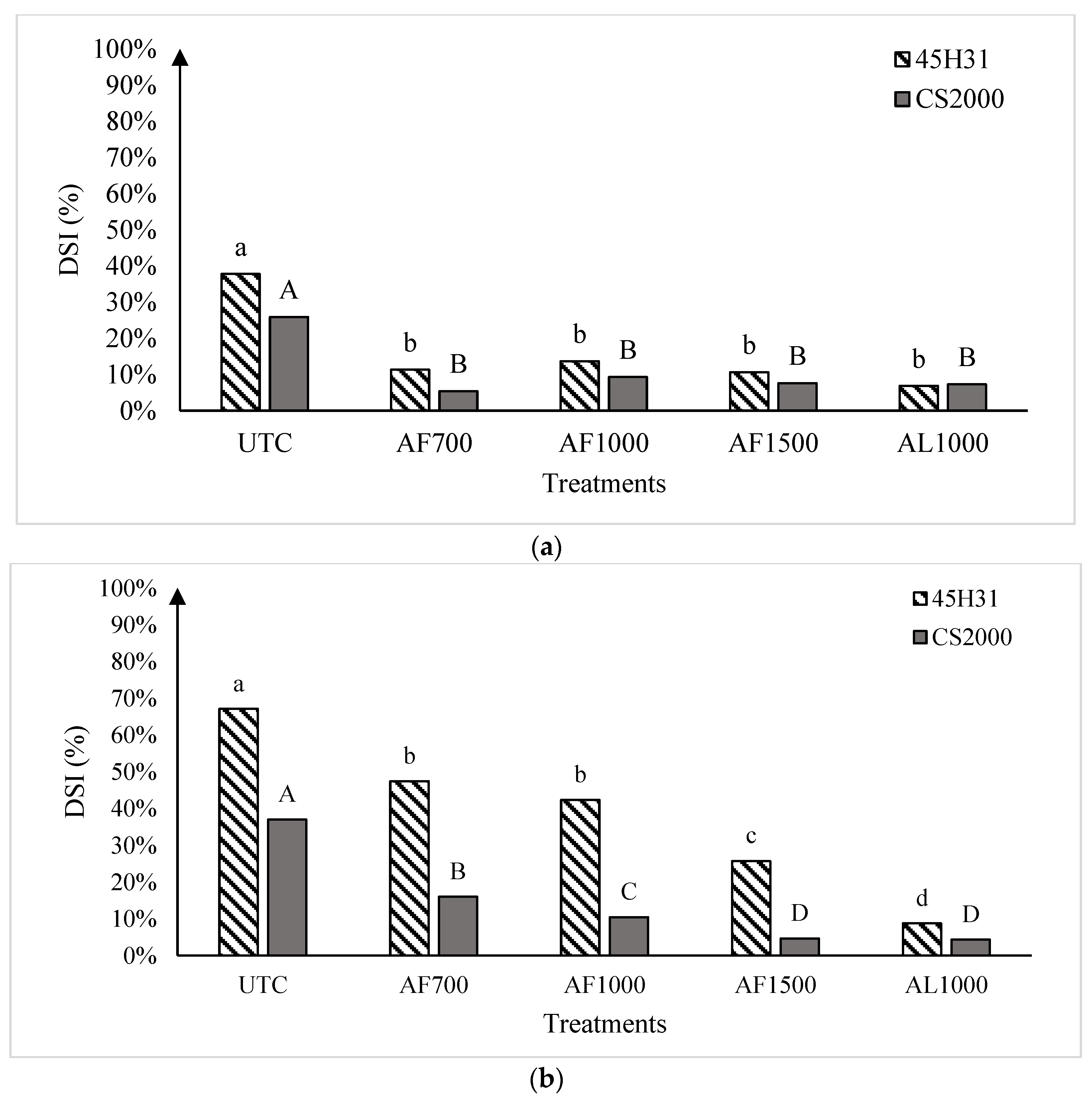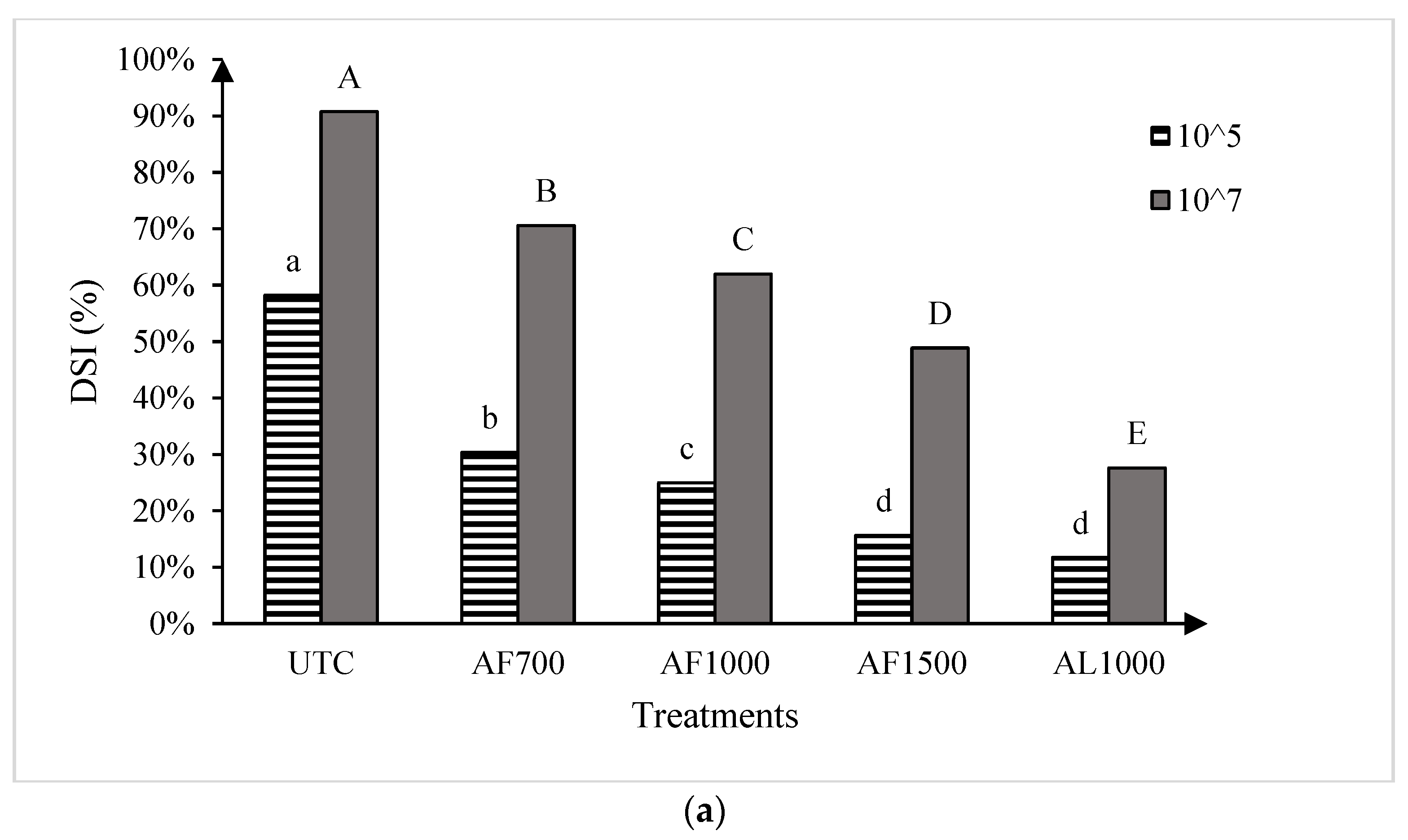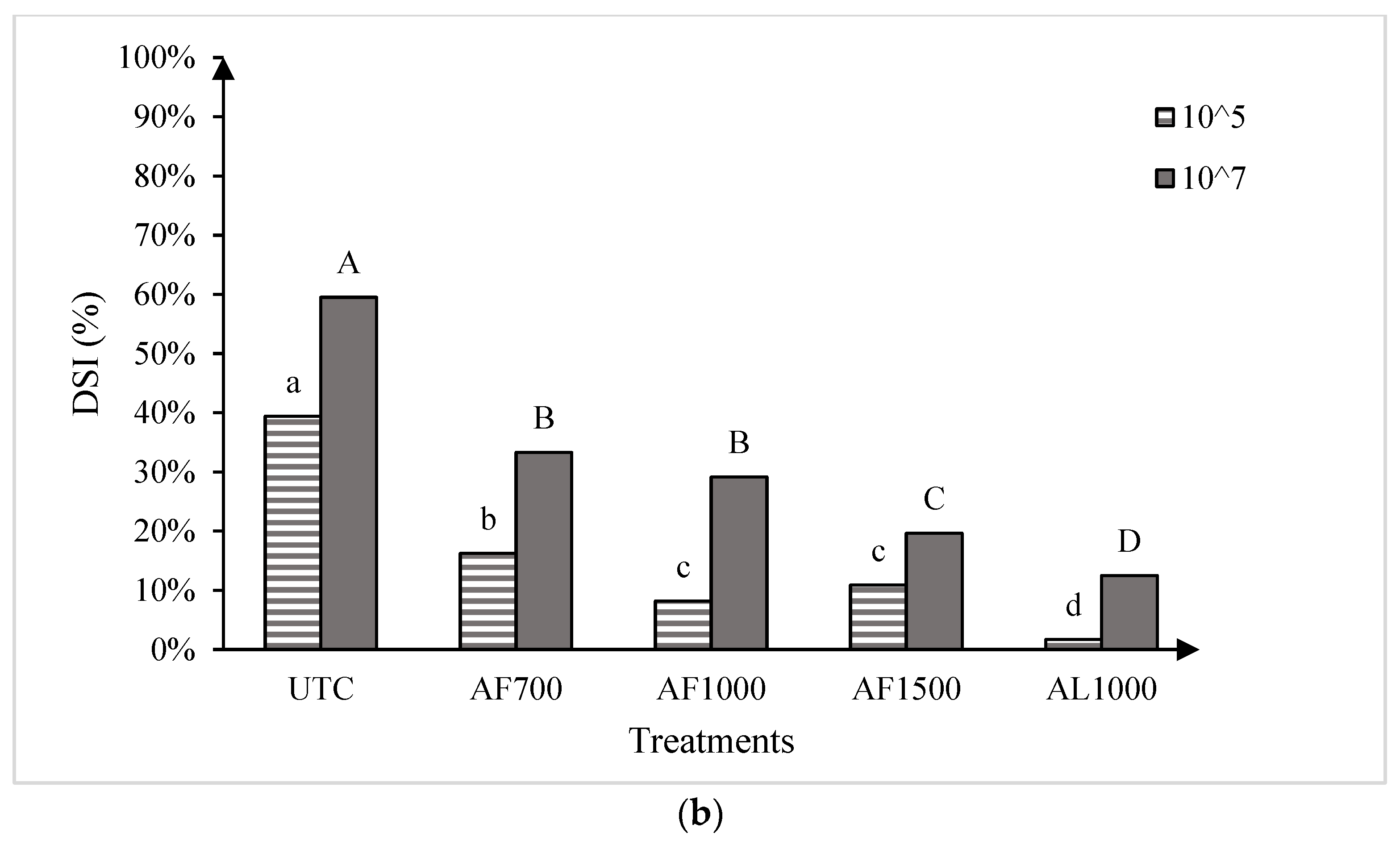Evaluation of Amisulbrom Products for the Management of Clubroot of Canola (Brassica napus)
Abstract
1. Introduction
2. Results
2.1. Effect of Amisulbrom on Resting Spore Germination
2.2. Effect of Amisulbrom on Resting Spore Viability
2.3. Field Trials
2.4. Greenhouse Trials
2.5. Resting Spore Densities
3. Discussion
4. Materials and Methods
4.1. Amisulbrom
4.2. Effect of Amisulbrom on Resting Spore Germination
4.3. Effect of Amisulbrom on Resting Spore Viability
4.4. Field Trials
4.5. Greenhouse Trials
4.6. Assessment of Clubroot Severity
4.7. PCR and qPCR Analysis
4.8. Data Analysis
Supplementary Materials
Author Contributions
Funding
Data Availability Statement
Acknowledgments
Conflicts of Interest
References
- Zheng, Q.; Liu, K. Worldwide Rapeseed (Brassica napus L.) Research: A Bibliometric Analysis during 2011–2021. Oil Crop Sci. 2022, 7, 157–165. [Google Scholar] [CrossRef]
- Cornelsen, J.E.J.; Ort, N.W.W.; Gabert, R.K.; Epp, I.; Rempel, C.B. Current and Potential Pest Threats for Canola in the Canadian Prairies. Pest Manag. Sci. 2023. [Google Scholar] [CrossRef] [PubMed]
- Wallenhammar, A.-C. Prevalence of Plasmodiophora brassicae in a Spring Oilseed Rape Growing Area in Central Sweden and Factors Influencing Soil Infestation Levels. Plant Pathol. 1996, 45, 710–719. [Google Scholar] [CrossRef]
- Hwang, S.F.; Ahmed, H.U.; Zhou, Q.; Rashid, A.; Strelkov, S.E.; Gossen, B.D.; Peng, G.; Turnbull, G.D. Effect of Susceptible and Resistant Canola Plants on Plasmodiophora brassicae Resting Spore Populations in the Soil: Plasmodiophora brassicae Spore Populations. Plant Pathol. 2013, 62, 404–412. [Google Scholar] [CrossRef]
- Donald, C.; Porter, I. Integrated Control of Clubroot. J. Plant Growth Regul. 2009, 28, 289–303. [Google Scholar] [CrossRef]
- Strelkov, S.E.; Hwang, S.-F.; Manolii, V.P.; Cao, T.; Feindel, D. Emergence of New Virulence Phenotypes of Plasmodiophora brassicae on Canola (Brassica Napus) in Alberta, Canada. Eur. J. Plant Pathol. 2016, 145, 517–529. [Google Scholar] [CrossRef]
- Strelkov, S.E.; Hwang, S.-F.; Manolii, V.P.; Cao, T.; Fredua-Agyeman, R.; Harding, M.W.; Peng, G.; Gossen, B.D.; Mcdonald, M.R.; Feindel, D. Virulence and Pathotype Classification of Plasmodiophora brassicae Populations Collected from Clubroot Resistant Canola (Brassica napus) in Canada. Can. J. Plant Pathol. 2018, 40, 284–298. [Google Scholar] [CrossRef]
- Hollman, K. Pathotypes of Plasmodiophora brassicae from Clubroot Resistant Canola and Assessment of Amisulbrom for Clubroot Control. 2021. Master’s Thesis, University of Alberta, Edmonton, AB, Canada. [CrossRef]
- Buczacki, S.T.; White, J.G. Preliminary Glasshouse and Field Tests of Soil Partial Sterilants for Clubroot Control. Ann. Appl. Biol. 1977, 85, 265–275. [Google Scholar] [CrossRef]
- Hwang, S.F.; Ahmed, H.U.; Zhou, Q.; Strelkov, S.E.; Gossen, B.D.; Peng, G.; Turnbull, G.D. Efficacy of Vapam Fumigant against Clubroot (Plasmodiophora brassicae) of Canola. Plant Pathol. 2014, 63, 1374–1383. [Google Scholar] [CrossRef]
- Zuzak, K.A.; Strelkov, S.E.; Turnbull, G.D.; Manolii, V.P.; Hwang, S.-F. Soil Fumigation with Vapam (Metam sodium) to Control Clubroot (Plasmodiophora brassicae) of Canola (Brassica napus). Can. J. Plant Sci. 2023, 103, 29–38. [Google Scholar] [CrossRef]
- Naiki, T.; Dixon, G.R. The Effects of Chemicals on Developmental Stages of Plasmodiophora brassicae (Clubroot). Plant Pathol. 1987, 36, 316–327. [Google Scholar] [CrossRef]
- Tanaka, S.; Kochi, S.; Kunita, H.; Ito, S.; Kameya-Iwaki, M. Biological Mode of Action of the Fungicide, Flusulfamide, against Plasmodiophora brassicae (Clubroot). Eur. J. Plant Pathol. 1999, 105, 577–584. [Google Scholar] [CrossRef]
- Mitani, S.; Sugimoto, K.; Hayashi, H.; Takii, Y.; Ohshima, T.; Matsuo, N. Effects of Cyazofamid against Plasmodiophora brassicae Woronin on Chinese Cabbage. Pest. Manag. Sci. 2003, 59, 287–293. [Google Scholar] [CrossRef] [PubMed]
- Yamaguchi, I.; Fujimura, M. Recent Topics on Action Mechanisms of Fungicides. J. Pestic. Sci. 2005, 30, 67–74. [Google Scholar] [CrossRef]
- Hwang, S.F.; Cao, T.; Xiao, Q.; Ahmed, H.U.; Manolii, V.P.; Turnbull, G.D.; Gossen, B.D.; Peng, G.; Strelkov, S.E. Effects of Fungicide, Seeding Date and Seedling Age on Clubroot Severity, Seedling Emergence and Yield of Canola. Can. J. Plant Sci. 2012, 92, 1175–1186. [Google Scholar] [CrossRef]
- Hwang, S.F.; Strelkov, S.E.; Gossen, B.D.; Turnbull, G.D.; Ahmed, H.U.; Manolii, V.P. Soil Treatments and Amendments for Amelioration of Clubroot of Canola. Can. J. Plant Sci. 2011, 91, 999–1010. [Google Scholar] [CrossRef]
- Honda, T.; Hasunuma, N.; Nishioka, M. Amisulbrom (NC-224): Performance of New Fungicide for Potato Late Blight Control. PPO-Spec. Rep. 2007, 12, 59–65. [Google Scholar]
- Honda, T.; Hasunuma, N.; Tanaka, A.; Sasaki, K.; Wakayama, K. Characteristics of Amisulbrom as a Foliar Use Fungicide on Oomycetes Disease. PPO-Spec. Rep. 2009, 13, 269–274. [Google Scholar]
- Fontaine, S.; Remuson, F.; Caddoux, L.; Barrès, B. Investigation of the Sensitivity of Plasmopara Viticola to Amisulbrom and Ametoctradin in French Vineyards Using Bioassays and Molecular Tools. Pest. Manag. Sci. 2019, 75, 2115–2123. [Google Scholar] [CrossRef]
- Kawasaki, Y.; Sumida, M.; Nishioka, T.; Sano, S.; Kawaradani, M.; Okada, K. Control of Clubroot Disease on Brassica campestris var. amplexicaulis (Shirona) by Amisulbrom and Dolomite-Converter Slag. Annu. Rep. Kansai Plant Prot. Soc. 2014, 56, 77–79. [Google Scholar] [CrossRef][Green Version]
- Hollman, K.B.; Manolii, V.P.; Aigu, Y.; Harding, M.W.; Hwang, S.-F.; Strelkov, S.E. Characterization of Plasmodiophora brassicae Pathotypes from Western Canada in 2019–2020. Can. J. Plant Pathol. 2023, 45, 475–484. [Google Scholar] [CrossRef]
- Kim, C.H.; Cho, W.D.; Kim, H.M. Yield Loss of Spring Chinese Cabbage as Affected by Infection Time of Clubroot Disease in Fields. Plant Dis. Res. 2000, 6, 23–26. [Google Scholar]
- Chai, A.L.; Xie, X.W.; Shi, Y.X.; Li, B.J. Research Status of Clubroot (Plasmodiophora brassicae) on Cruciferous Crops in China. Can. J. Plant Pathol. 2014, 36, 142–153. [Google Scholar] [CrossRef]
- Hwang, S.-F.; Howard, R.J.; Strelkov, S.E.; Gossen, B.D.; Peng, G. Management of Clubroot (Plasmodiophora brassicae) on Canola (Brassica napus) in Western Canada. Can. J. Plant Pathol. 2014, 36, 49–65. [Google Scholar] [CrossRef]
- Lombi, E.; McLaughlin, M.J.; Johnston, C.; Armstrong, R.D.; Holloway, R.E. Mobility and Lability of Phosphorus from Granular and Fluid Monoammonium Phosphate Differs in a Calcareous Soil. Soil Sci. Soc. Am. J. 2004, 68, 682–689. [Google Scholar] [CrossRef]
- Nakanishi, M.; Mori, M. Effect of Slaked Lime on Controlling Clubroot of Broccoli and Its Influence on the Plant Growth. Soil Microorganisms 2017, 71, 13. [Google Scholar] [CrossRef]
- Fox, N.M.; Hwang, S.-F.; Manolii, V.P.; Turnbull, G.; Strelkov, S.E. Evaluation of Lime Products for Clubroot (Plasmodiophora brassicae) Management in Canola (Brassica napus) Cropping Systems. Can. J. Plant Pathol. 2022, 44, 21–38. [Google Scholar] [CrossRef]
- Hwang, S.F.; Strelkov, S.E.; Ahmed, H.U.; Manolii, V.P.; Zhou, Q.; Fu, H.; Turnbull, G.; Fredua-Agyeman, R.; Feindel, D. Virulence and Inoculum Density-Dependent Interactions between Clubroot Resistant Canola (Brassica napus) and Plasmodiophora brassicae. Plant Pathol 2017, 66, 1318–1328. [Google Scholar] [CrossRef]
- Ernst, T.W.; Kher, S.; Stanton, D.; Rennie, D.C.; Hwang, S.F.; Strelkov, S.E. Plasmodiophora brassicae Resting Spore Dynamics in Clubroot Resistant Canola (Brassica napus) Cropping Systems. Plant Pathol. 2019, 68, 399–408. [Google Scholar] [CrossRef]
- Wallenhammar, A.C.; Johnsson, L.; Gerhardson, B. Clubroot Resistance and Yield Loss in Spring Oilseed Turnip Rape and Spring Oilseed Rape. In Proceedings of the 10th International Rapeseed Congress, Canberra, Australia, 26–29 September 1999. [Google Scholar]
- Strehlow, B.; De Mol, F.; Struck, C. Risk Potential of Clubroot Disease on Winter Oilseed Rape. Plant Dis. 2015, 99, 667–675. [Google Scholar] [CrossRef]
- Botero-Ramírez, A.; Hwang, S.-F.; Strelkov, S.E. Effect of Clubroot (Plasmodiophora brassicae) on Yield of Canola (Brassica napus). Can. J. Plant Pathol. 2022, 44, 372–385. [Google Scholar] [CrossRef]
- Lahlali, R.; Peng, G.; McGregor, L.; Gossen, B.D.; Hwang, S.F.; McDonald, M. Mechanisms of the Biofungicide Serenade (Bacillus Subtilis QST713) in Suppressing Clubroot. Biocontrol Sci. Technol. 2011, 21, 1351–1362. [Google Scholar] [CrossRef]
- Macfarlane, I. Germination of Resting Spores of Plasmodiophora brassicae. Trans. Br. Mycol. Soc. 1970, 55, 97–112. [Google Scholar] [CrossRef]
- Suzuki, K.; Matsumiya, E.; Ueno, Y.; Mizutani, J. Some Properties of Germination-Stimulating Factor from Plants for Resting Spores of Plasmodiophora brassicae. Jpn. J. Phytopathol. 1992, 58, 699–705. [Google Scholar] [CrossRef]
- Strelkov, S.E.; Tewari, J.P.; Smith-Degenhardt, E. Characterization of Plasmodiophora brassicae Populations from Alberta, Canada. Can. J. Plant Pathol. 2006, 28, 467–474. [Google Scholar] [CrossRef]
- Naiki, T.; Dixon, G.R.; Ikegami, H. Quantitative Estimation of Spore Germination of Plasmodiophora brassicae. Trans. Br. Mycol. Soc. 1987, 89, 569–572. [Google Scholar] [CrossRef]
- Newcombe, G.; Thomas, P.L. Fungicidal and Fungistatic Effects of Carboxin on Ustilago nuda. Phytopathology 1990, 80, 509–512. [Google Scholar] [CrossRef]
- Harding, M.W.; Hill, T.B.; Yang, Y.; Daniels, G.C.; Hwang, S.F.; Strelkov, S.E.; Howard, R.J.; Feng, J. An Improved Evans Blue Staining Method for Consistent, Accurate Assessment of Plasmodiophora brassicae Resting Spore Viability. Plant Dis. 2019, 103, 2330–2336. [Google Scholar] [CrossRef]
- Kuginuki, Y.; Yoshikawa, H.; Hirai, M. Variation in Virulence of Plasmodiophora brassicae in Japan Tested with Clubroot-Resistant Cultivars of Chinese Cabbage (Brassica Rapa L. Ssp. Pekinensis). Euro. J. Plant Pathol. 1999, 105, 327–332. [Google Scholar] [CrossRef]
- Horiuchi, S.; Hori, M. A Simple Greenhouse Technique for Obtaining High Levels of Clubroot Incidence. Bull. Chugoku Natl. Agric. Exp. Stn. 1980, 17, 33–35. [Google Scholar]
- Cao, T.; Tewari, J.; Strelkov, S.E. Molecular Detection of Plasmodiophora brassicae, Causal Agent of Clubroot of Crucifers, in Plant and Soil. Plant Dis. 2007, 91, 80–87. [Google Scholar] [CrossRef] [PubMed]
- Rennie, D.C.; Manolii, V.P.; Cao, T.; Hwang, S.F.; Howard, R.J.; Strelkov, S.E. Direct Evidence of Surface Infestation of Seeds and Tubers by Plasmodiophora brassicae and Quantification of Spore Loads: Seeds/Tubers Infestation Plasmodiophora brassicae. Plant Pathol. 2011, 60, 811–819. [Google Scholar] [CrossRef]
- Mendiburu, F.D.; Simon, R. Agricolae—Ten Years of an Open Source Statistical Tool for Experiments in Breeding, Agriculture and Biology. PeerJ 2015, 3, e1404v1. [Google Scholar] [CrossRef]





| Treatment | Plant Height (cm) | Plant Biomass (g) | Yield (t/ha) | ||||||
|---|---|---|---|---|---|---|---|---|---|
| 2019 | 2020S1 | 2020S2 | 2019 | 2020S1 | 2020S2 | 2019 | 2020S1 | 2020S2 | |
| UTC | 87.81 c | 127.48 b | 96.68 a | 100.89 b | 95.65 b | 67.23 c | 0.95 a | 2.48 d | 1.10 b |
| AF700 | 94.51 b | 134.78 ab | 99.81 a | 110.44 ab | 139.13 a | 94.36 bc | 1.44 a | 2.64 cd | 1.53 ab |
| AF1000 | 94.79 b | 133.03 ab | 101.81 a | 111.71 ab | 125.12 ab | 85.27 c | 1.41 a | 2.95 bc | 1.55 ab |
| AF1500 | 98.47 a | 132.91 ab | 103.93 a | 119.22 a | 165.13 a | 127.21 ab | 1.36 a | 3.24 ab | 1.88 a |
| AL1000 | 96.62 ab | 142.82 a | 103.15 a | 111.17 ab | 143.97 a | 131.51 a | 0.99 a | 3.54 a | 1.98 a |
| Treatment | Plant Height (cm) | Plant Biomass (g) | Yield (t/ha) | ||||||
|---|---|---|---|---|---|---|---|---|---|
| 2019 | 2020S1 | 2020S2 | 2019 | 2020S1 | 2020S2 | 2019 | 2020S1 | 2020S2 | |
| UTC | 100.08 c | 145.10 a | 101.47 a | 129.84 b | 117.88 b | 103.75 a | 1.51 b | 2.83 b | 1.48 b |
| AF700 | 105.65 b | 137.20 a | 101.18 a | 135.44 b | 150.83 ab | 114.66 a | 2.27 a | 3.17 a | 1.82 ab |
| AF1000 | 105.70 b | 140.48 a | 100.24 a | 142.61 ab | 139.56 ab | 132.32 a | 2.06 ab | 3.20 a | 1.78 ab |
| AF1500 | 107.92 a | 144.31 a | 105.82 a | 157.42 a | 175.80 a | 148.64 a | 1.99 ab | 3.35 a | 2.23 a |
| AL1000 | 105.96 ab | 142.33 a | 99.91 a | 136.19 b | 155.83 a | 108.75 a | 2.18 ab | 3.24 a | 2.12 ab |
| Treatment | Plant Height (cm) | Plant Biomass (g) | ||
|---|---|---|---|---|
| 105 | 107 | 105 | 107 | |
| UTC | 83.64 c | 74.54 b | 14.59 b | 9.60 b |
| AF700 | 92.94 b | 81.68 ab | 17.07 b | 12.60 ab |
| AF1000 | 100.71 a | 81.92 ab | 23.66 a | 11.90 ab |
| AF1500 | 101.11 a | 82.38 ab | 22.30 a | 13.73 a |
| AL1000 | 86.97 bc | 85.47 a | 16.01 b | 12.85 a |
| Treatment | Plant Height (cm) | Plant Biomass (g) | ||
|---|---|---|---|---|
| 105 | 107 | 105 | 107 | |
| UTC | 89.49 d | 79.24 b | 15.12 b | 12.32 c |
| AF700 | 96.32 bc | 85.46 ab | 21.08 a | 14.92 b |
| AF1000 | 106.07 a | 88.99 a | 22.05 a | 15.98 ab |
| AF1500 | 100.61 b | 88.78 a | 22.21 a | 16.78 a |
| AL1000 | 93.15 cd | 87.75 a | 19.64 a | 15.53 ab |
| Treatment | Amisulbrom Rate | Formulation |
|---|---|---|
| UTC | 0 | N.A. |
| AF700 | 700 g ai/ha | Granular |
| AF1000 | 1000 g ai/ha | Granular |
| AF1500 | 1500 g ai/ha | Granular |
| AL1000 | 1000 g ai/ha | Liquid |
Disclaimer/Publisher’s Note: The statements, opinions and data contained in all publications are solely those of the individual author(s) and contributor(s) and not of MDPI and/or the editor(s). MDPI and/or the editor(s) disclaim responsibility for any injury to people or property resulting from any ideas, methods, instructions or products referred to in the content. |
© 2023 by the authors. Licensee MDPI, Basel, Switzerland. This article is an open access article distributed under the terms and conditions of the Creative Commons Attribution (CC BY) license (https://creativecommons.org/licenses/by/4.0/).
Share and Cite
Yu, Z.; Strelkov, S.E.; Hwang, S.-F. Evaluation of Amisulbrom Products for the Management of Clubroot of Canola (Brassica napus). Plants 2024, 13, 28. https://doi.org/10.3390/plants13010028
Yu Z, Strelkov SE, Hwang S-F. Evaluation of Amisulbrom Products for the Management of Clubroot of Canola (Brassica napus). Plants. 2024; 13(1):28. https://doi.org/10.3390/plants13010028
Chicago/Turabian StyleYu, Zhiyu, Stephen E. Strelkov, and Sheau-Fang Hwang. 2024. "Evaluation of Amisulbrom Products for the Management of Clubroot of Canola (Brassica napus)" Plants 13, no. 1: 28. https://doi.org/10.3390/plants13010028
APA StyleYu, Z., Strelkov, S. E., & Hwang, S.-F. (2024). Evaluation of Amisulbrom Products for the Management of Clubroot of Canola (Brassica napus). Plants, 13(1), 28. https://doi.org/10.3390/plants13010028






